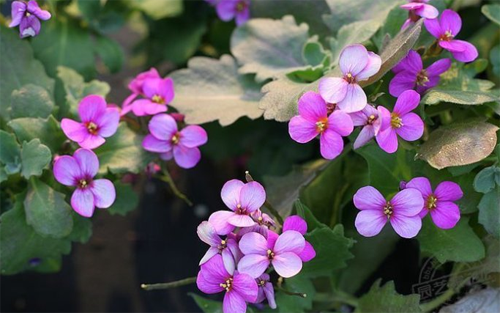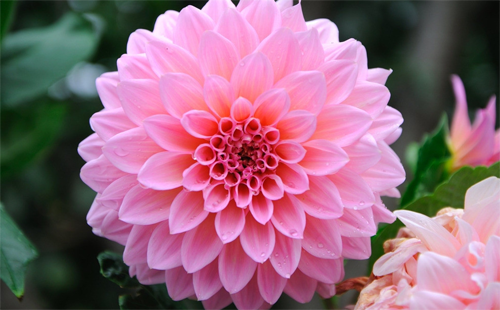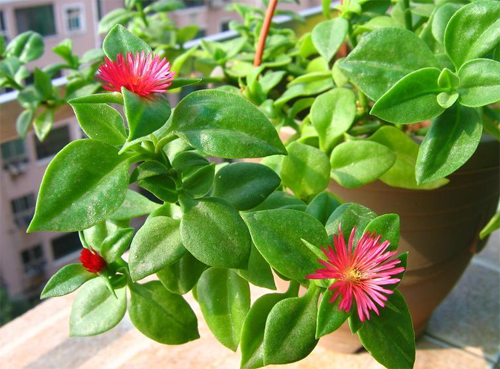How long is the flowering time of the planting method of Arabidopsis thaliana
Many people don't like farming very much in Arabidopsis thaliana. Arabidopsis thaliana is a flower growing in rocks. Let's take a look at the planting method of Arabidopsis thaliana. How long is the florescence?

Planting methods of Arabidopsis thaliana
Arabidopsis thaliana is generally sown, like can buy seeds to try, spring and autumn sowing is OK, generally autumn is the most suitable, the next year can blossom a little bit, can raise two or three years!
It is a very adaptable plant, so it is necessary to be tolerant to drought, cold and shade. What it likes most is a cold and dry climate, but we should pay attention to the fact that it does not like the hot environment and stagnant water. Of course, the biggest advantage of it is that it does not pick the soil to grow, otherwise how can it grow in the rocks!
Introduction to growing period maintenance:
Its seedlings grow very fast, especially in the cold autumn environment, if the sun is a little more than 1.1, and it is resistant to drought and barren, it is very suitable for lazy people, it can survive at minus 15, and it is dangerous if it is lower.
In general, when two pairs (four) of true leaves grow after sowing in autumn, the seedlings of the times, each plant should leave a certain distance, (about 10 centimeters) to ensure that each one should be strong.
Be sure to transplant with soil when transplanting, it is very fragile at that time, you should take good care of it. Notice that you can pinch the top properly when you grow to about 15 centimeters, but some begin to blossom about 10 centimeters, depending on the intensity of the light.
Breeders remember to keep the basin soil slightly moist, cover it with a thin film, keep warm and moisturizing, like two real leaves on it will lift the film and slowly see the light.
Note: nutrient soil before sowing and transplanting should do a good job of disinfection and sterilization, of course, the planting will be ignored!
How long does it blossom in autumn?
Planting southern mustard in greenhouse, if it is sown in spring, it usually blossoms after 3 months. Of course, autumn sowing will spend the winter in the greenhouse, sowing around September and October, usually in April (if the species in the south may be deviated).
Grow in the cracks in the rock, a little soil can be, it still looks good!
Seed disinfection is to soak in water before sowing, and then soak in carbendazim.
Florescence of Arabidopsis thaliana:
Florescence is from May to July, belonging to very good courtyard florets, generally can be seen in some courtyards, rock gardens, layout in the courtyard is also a good choice.
This is the end of the introduction on the breeding method and florescence of Arabidopsis thaliana. Let's take a look at it.
Introduction of Aubrieta cultorum Aubrieta cultorum: how to grow Aubrieta cultorum / how to propagate Arabidopsis thaliana Culture methods and precautions for Arabidopsis thaliana Aubrieta cultorum belongs to Cruciferae. Arabidopsis thaliana has strong vitality, strong adaptability and easy to cultivate. Arabidopsis thaliana is a perennial herb, tufted but not cushion-shaped, with stellate or forked hairs; leaves small, entire or hornlike serrate; racemes terminal with few and large flowers, purple, pansy or white. Flower diameter 1.2cm, with strong fragrance; flowers purple to lavender, flowering from May to June. Because of its early flowering and large number of flowers, Arabidopsis thaliana is a very good variety used in early spring. It can be used in all kinds of dwarf combinations, as well as villas, parks, rock gardens and other places. Most of them are cultivated as flower beds and rocks, with low stems with stellate hairs and simple leaves. Leaves small linear to spatulate alternate, dense raceme calyx erect flowers small white, blue, purple narrow spatulate oblong. Apical emarginate to entire short siliques. The morphological characteristics of Arabidopsis thaliana are perennial perennial flowers, often cultivated in one or two years, with a height of 20-30 cm and 3400 seeds per gram. Southern mustard plants 20-30 cm tall tufted, but not cushion-shaped with stellate or forked hairs much branched and creeping plant height 1530cm. Leaf leaflets alternate-lanceolate-entire or angularly serrate. Racemes terminal flowers few and large, purple, pansy or white. Simple morphological characteristics and strong vitality can be cultured artificially with ordinary medium, with 3400 seeds per gram. There are also foliage varieties such as large flowers and white margin and variegated leaves with slight fragrance, and the seeds of large flowers and white margin foliage varieties are flat in florescence in 36 months. Flower diameter 1.2cm with purple to lavender flowering period from May to June. The ecological habits of Arabidopsis thaliana prefer light tolerance to drought and low temperature of minus 15 degrees Celsius, so it is required to be sunny and slightly shady. Nanting mustard likes cold and dry climate, does not tolerate cold and heat, likes loose and well-drained soil, and avoids stagnant water to tolerate dry and barren soil. Cultivation techniques of Arabidopsis thaliana seedlings grow rapidly, like cold and cool, avoid hot, require sufficient sunshine, slightly tolerant to shade, light soil, avoid waterlogging, and are more resistant to drought and barren. The suitable temperature for growth is 5-25 ℃. If the growth period of southern mustard cultured in the room is different, the method of moisturizing the local plastic film of the seedlings can be adopted without maintaining the whole culture room at a high humidity. Then in the transplanting plant row spacing is 1010 cm to ensure that the plant individual growth is robust, firm and full, this distance is easy to cultivate and at this time the pot stylist is the most beautiful. Planting management after the seedlings grow at least 2 pairs of true leaves, the seedlings can be properly separated so that there is a certain distance between the plants to ensure that the individual growth of the plant is robust, firm and full. The decisive factor for flowering of plants with a dark / photoperiod of 12 or 14 hours is the length of sunlight, which is not necessarily related to the size of the plant. Some plants blossom only when O5cm is high. When the light intensity is between 80 °C and 120 °C, the light intensity should not exceed 25 °C. when sowing, the vernalization seeds can be sowed directly on the pre-soaked nutritious soil. The seeds should be sowed near the surface of the mixed soil in the mixture of vermiculite and vermiculite in the flower market. In order to ensure the neatness of seedling emergence, several seeds can be sown at each point. In order to maintain humidity, the pot or seedling tray can be covered with plastic film after sowing, and then the film can be removed after the seedlings grow 2 pairs of true leaves. The temperature of the culture room was 20 °C. Cultivation of Arabidopsis thaliana often encounter the harm of aphids can be used alternately with 2000 to 3000 times diluted alfampicin or insect mite Zeke according to the insect condition. In order to prevent diseases and insect pests, attention should also be paid to the sterilization of the nutrient soil used and the treatment of insecticidal eggs, especially the nutrient soil that has occurred diseases and insect pests in the course of use, or should be discarded and no longer used. The cultivation method of Arabidopsis thaliana: how long does it blossom in autumn? sow in greenhouse and sow in greenhouse. If the conditions are good after sowing in spring, it will blossom in about 3 months. If you sow in autumn, you will have to spend the winter in greenhouse, sow seeds around October, and blossom in April next year. The reproduction mode of southern mustard is not only broadcast propagation, but also cuttage propagation. The sowing method is suitable for germination temperature 16-19 ℃, seed sowing, seedling substrate should be soft, good air permeability, sand-covered soil about 2 times the diameter of seeds, maintain humidity, about 5-8 days. It can be sown in spring and autumn, the germination temperature is 15-20 degrees, germinates in 7-14 days, and blossoms in spring sowing for 3 months. Germination is suitable for 16-19 ℃, seed sowing, seedling substrate should be soft, good air permeability, covered with sandy soil about 2 times the diameter of seeds, maintain humidity, about 5-8 days to emerge. Seedlings grow rapidly, like cold and cool, avoid hot, require sufficient sunshine, slightly resistant to shade, easy soil, avoid waterlogging, more resistant to drought and barren. The suitable temperature for growth is 5-25 ℃. The treatment of seeds before sowing had better disinfect and vernalize the seeds before sowing. The seeds can be disinfected for 10 minutes with the mixture of 0.5 hypochlorite and 0.01mol / L Triton-X and then washed with sterile water for 3-4 times to avoid plant diseases. The same method can be used to disinfect the seeds of seedlings that sometimes need to be cultured under aseptic conditions. Vernalization of seeds is not necessary, but vernalization can effectively improve the germination rate of seeds. The vernalization treatment of the seeds can be carried out directly in the general refrigerator for about 4 ℃. The sterilized seeds can be sown after vernalization for 2 to 3 days under humid conditions. Sowing methods in spring and autumn can be sowed and germinated at a temperature of 15-20 degrees for 7-14 days and blossomed in spring for 3 months. The suitable temperature for germination is 16-19 ℃ seed sowing and seedling substrate should be soft and breathable, covering sand soil should be about 2 times of seed diameter and maintain humidity for about 5-8 days. The recommended sowing rate is 0.5g/m2. Autumn sowing blossoms in May of the following year. Cutting propagation before summer, heavy cutting and placing cool places in summer will blossom more after autumn. The rapid growth of seedlings likes cold, cool and hot, which requires that the sun is sufficient, the shade is better, the soil is less waterlogged, and the soil is more resistant to drought and barren. The suitable temperature for growth is 5-25 ℃. The disease control culture of Arabidopsis thaliana will often encounter the harm of aphids, so it can be used alternately with 2000 to 3000 times diluted alfampicin or insect mite Zeke according to the pest situation. In order to prevent diseases and insect pests, attention should also be paid to the sterilization of the nutrient soil used and the treatment of insecticidal eggs, especially the nutrient soil that has occurred diseases and insect pests in the course of use, or should be discarded and no longer used. Classification, species and varieties of Arabidopsis thaliana 1. Herbs with high 1530cm stem tufted with cushion-like base woody. Also oblanceolate sometimes with spoon-shaped, light toothed gray soft hairs with long 510cm. The golden flowers bloom in April. It is the main cultivated species in this book. The origin of south-central and central Europe spread from southern Europe in 1710 from the United Kingdom suitable for rock garden and small pot cultivation. There are also varieties of lithophytic mustard plants with low tufted flowers. Double rock mustard. Double. two。 Rhizoma mandshurica has a high 1020cm plant type, low and compact. Leaves Obovate-oblong to linearly covered with stellate silver-gray hairs. The flowers are yellow with strong aroma. The florescence is June and July. Origin of south-central Europe and the Caucasus. In addition, the florescence of the large flower variety was spread from Germany to England in May and June 1713. 3. Alpine mustard ratoon herb is a tall dwarf species with only 9cm. Leaves Obovate to linear grayish green. Short racemes. The flowers are yellow. Flowering in spring. 1777 cattle originally from Europe are mostly planted in small pots according to the transmission to the United Kingdom. 4. The high aroma of aromatic mustard is suitable for potted plants. Ecological habits: court mustard likes cool and sunny places, but not resistant to hot summer and rainy and humid climate, so it is suitable for biennial cultivation. Although the mustard does not choose the soil, it grows better with slightly calcareous soil and good drainage. Propagation and cultivation: the germination ability of germinated seeds can be maintained for 23 years after sowing in September and autumn for about 2 weeks. The buds can also be propagated in September. When transplanting seedlings, the root system should carry more soil, otherwise it is not easy to survive. Garden use: the plant type of mustard is small and complex, which is suitable for planting on the edge of flower mirror or arranging rock garden. Potted use of Arabidopsis thaliana is a good material for flower beds, flower borders and rock circles. It can also be used for pot planting and ground use. Its vitality is very strong and adaptable, and it is easy to cultivate. The greening function of Nanting mustard fragrance is an excellent material for flower beds and flower border edges, which is suitable for planting on the wall edge of the rock garden and can also be used as potted plants and ground covers. The garden use of Arabidopsis thaliana flowering early, large number of flowers, is a very good variety in early spring, can be used in all kinds of dwarf combinations, can also be used in villas, parks, rock gardens and other places. The flower language of southern mustard: the temptation of the soul. Cultivation and cultivation of Arabidopsis thaliana
Southern mustard other name blue mustard, Latin name: aubrieta cultorum family genus: + word flower family, southern mustard indecent appreciation period: April to June
Breeding mode: sowing in spring and autumn, budding temperature 15-20 degrees, sprouting in 7-14 days, spring sowing and flowering in 3 months. The suitable temperature for sprouting is 16-19 degrees Celsius, and the seed is sown. The seedling substrate needs to be soft and breathable. The diameter of the seed covered with sandy soil is about 2 times, and the humidity is maintained, and the seedlings emerge in about 5-8 days. Seedling development is agile, like cold and cool, avoid extreme heat, require plenty of sunshine, slightly resistant to shade, easy soil, avoid waterlogging, more resistant to drought and barren. Develop a suitable temperature of 5-25 degrees Celsius.
- Prev

When will the root planting method of Dahlia be planted?
The flowers of Dahlia are big flowers, they are very beautiful, and people like them very much. Dahlia is usually planted with root. Let's take a look at the method of planting Dahlia with root.
- Next

Can the culture methods and matters needing attention of peony orchid be eaten?
Peony hanging orchid is a kind of plant that many people like to cultivate, and it is also very delicate. What are the breeding methods and matters needing attention of peony hanging orchid? Can peony orchids be eaten? The cultivation methods and precautions of peony orchid: light and temperature, as mentioned above, it does not need too much light to blossom.
Related
- Fuxing push coffee new agricultural production and marketing class: lack of small-scale processing plants
- Jujube rice field leisure farm deep ploughing Yilan for five years to create a space for organic food and play
- Nongyu Farm-A trial of organic papaya for brave women with advanced technology
- Four points for attention in the prevention and control of diseases and insect pests of edible fungi
- How to add nutrient solution to Edible Fungi
- Is there any good way to control edible fungus mites?
- Open Inoculation Technology of Edible Fungi
- Is there any clever way to use fertilizer for edible fungus in winter?
- What agents are used to kill the pathogens of edible fungi in the mushroom shed?
- Rapid drying of Edible Fungi

